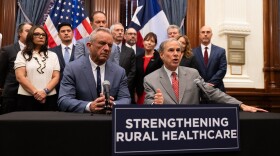Twenty-four-year-old Kalee Woody says that when she was growing up in Bronaugh, Missouri, she saw the small town slowly fading. Businesses closed, growth stagnated and residents had to drive to other places to see a doctor.
It is a town that, like many towns in rural areas of Missouri and other Midwest and Great Plains states, is recognized by the federal government as having a shortage of healthcare providers.
Now, Woody wants to help. She enrolled in medical school and will start classes in July at the just-opened Kansas City University of Medicine and Biosciences (KCUMB) campus in Joplin, Missouri, the first new medical school in the state in nearly half a century. Woody wants to serve someday in a rural community much like the one she grew up in – where, as a doctor, she’ll also be seen as a pillar of the community.
“They have so much contact with different people. They just get to know everyone,” Woody says. “Everyone knows them and, by association, they become a leader.”
KCUMB is an osteopathic medical school, meaning that graduates emerge with a Doctorate of Osteopathic Medicine (D.O.) degree, rather than an M.D. degree. Osteopathic medical schools, whose numbers have doubled in the last 10 years, are in the middle of a push into smaller communities and some in the healthcare industry hope graduates could eventually help ease the current shortage of medical care in many rural areas.
“We’re going to have an opportunity to teach those students in a rural environment and show them how cool it really is to work there,” says Darrin D’Agostino, executive dean of KCUMB.
D’Agostino says osteopathic schools take a more holistic approach than M.D. programs, which accounts for the high percentage of D.O.s – 56% – going into primary care instead of specialties, according to the American Osteopathic Association. Less than a quarter of new MDs go into primary care, according to researchers at George Washington University.
D.O.s are licensed in the same way M.D.s are and these days, the care provided by D.O.s and M.D.s is typically so similar that most patients wouldn’t know the difference. But that hasn’t always been the case.
At the root of osteopathic medicine is osteopathic manipulative treatment, a hands-on technique that looks like a cross between chiropractic manipulation and massage. There is evidence this can help treat some kinds of pain.
It sounds New-Age-y, but the idea dates back to the days of the Old West.
In the late 1800s, a former Kansas state legislator and civil war surgeon, Andrew Taylor Still, decided to reconsider basic assumptions about medicine after he watched three of his children die from spinal meningitis.
“The therapeutic options were very different than we have available to us right now, and he thought that the available system of medicine simply didn’t work,” says Joel Howell, an M.D. and professor of the history of medicine at the University of Michigan, who has written about Still and the practice he invented.
Still eventually founded the first osteopathic school in Kirksville, Missouri, in order to teach his kind of medicine, which was based on a very different understanding of the body and human health.
“He set out to devise an alternative healing practice based on this notion that manipulation of the spine could improve blood flow and thus improve health by allowing the body to heal itself,” Howell says.
Osteopathic manipulation is now just one of the techniques that D.O.s are taught to use, along with mainstream treatments.
A recent burst of new osteopathic medical schools is part of a decades-long effort to move osteopathic physicians into practice throughout the country. Many are in states like Arkansas, Colorado and Tennessee that have very small numbers of working D.O.s.
Howell says these newly minted physicians can probably help out a lot in medically underserved parts of those states, but they may have to do some public relations work first.
“I think they should be prepared to explain what being a D.O. means,” Howell says.
The bigger challenge may be acceptance from M.D.s, who still dominate medicine and make up the preponderance of doctors. Almost all of the most prestigious medical schools such as Harvard, Stanford and Johns Hopkins churn out M.D.s.
“The general reception is that we ignore [osteopathic medicine,]” Howell says. “We don’t know much about it; we don’t do it. I think if pushed, most people would figure that for some kinds of illnesses, it doesn’t do any harm, and it might well help.”
Earlier in the summer, hundreds of curious Joplin residents turned out for the opening of the new KCUMB medical school. School and community leaders in this city of 51,000 in the southwestern corner of Missouri hope that in surrounding rural areas with a shortage of health care providers, patients won’t care much about whether someone’s a D.O. or an M.D. – just as long as they’re a doctor.
Copyright 2017 Harvest Public Media







